Report on Critical Thinking and Decision Making (MGT 312)
VerifiedAdded on 2022/08/28
|9
|1545
|21
Report
AI Summary
This report analyzes the principles of critical thinking and problem-solving, drawing upon insights from a Harvard Business School article and the MGT 312 course. The student explores how to enhance critical thinking by questioning assumptions, employing logical reasoning, and diversifying thought processes. The report examines the detrimental effects of groupthink and contrasts critical thinking with creative thinking. It also addresses the importance of analyzing cause and effect, classifying information, comparing and contrasting concepts, inferring logical conclusions, and evaluating information to make sound decisions. The student's work integrates practical examples from the article with theoretical frameworks from the course, offering a comprehensive perspective on critical thinking's role in leadership and decision-making, with the aim of avoiding common pitfalls in organizational settings and improving strategic thinking.
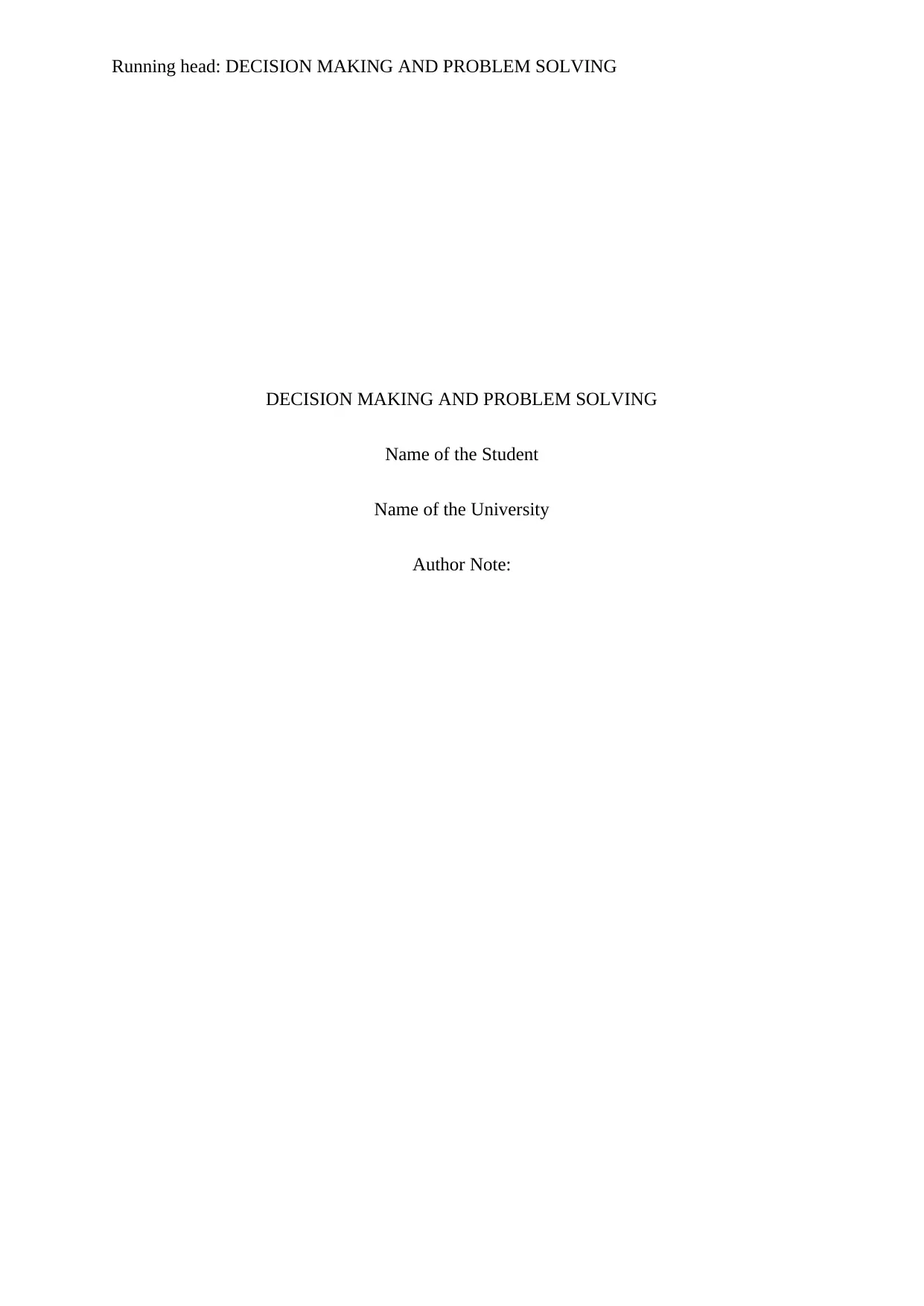
Running head: DECISION MAKING AND PROBLEM SOLVING
DECISION MAKING AND PROBLEM SOLVING
Name of the Student
Name of the University
Author Note:
DECISION MAKING AND PROBLEM SOLVING
Name of the Student
Name of the University
Author Note:
Paraphrase This Document
Need a fresh take? Get an instant paraphrase of this document with our AI Paraphraser
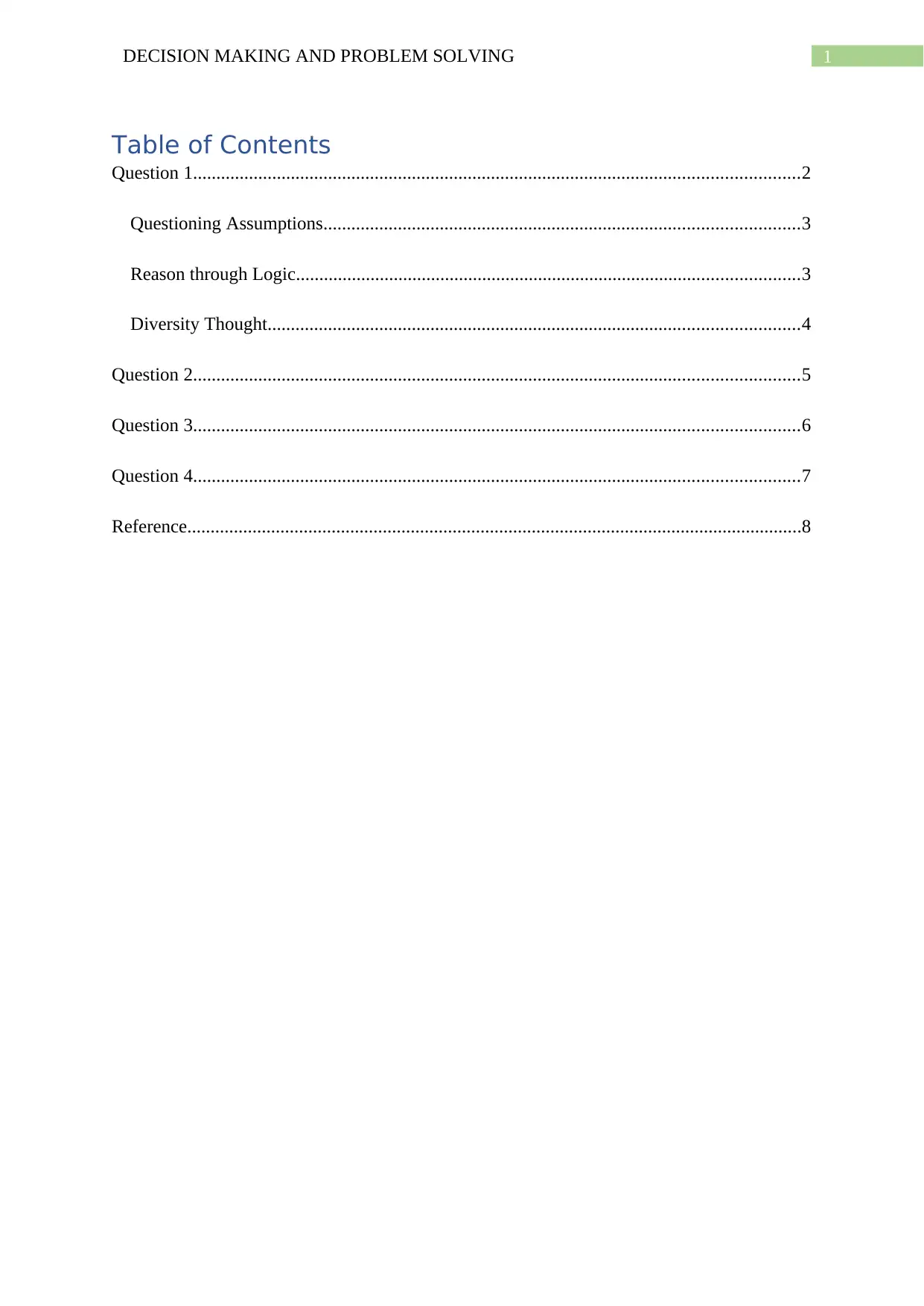
1DECISION MAKING AND PROBLEM SOLVING
Table of Contents
Question 1..................................................................................................................................2
Questioning Assumptions......................................................................................................3
Reason through Logic............................................................................................................3
Diversity Thought..................................................................................................................4
Question 2..................................................................................................................................5
Question 3..................................................................................................................................6
Question 4..................................................................................................................................7
Reference....................................................................................................................................8
Table of Contents
Question 1..................................................................................................................................2
Questioning Assumptions......................................................................................................3
Reason through Logic............................................................................................................3
Diversity Thought..................................................................................................................4
Question 2..................................................................................................................................5
Question 3..................................................................................................................................6
Question 4..................................................................................................................................7
Reference....................................................................................................................................8
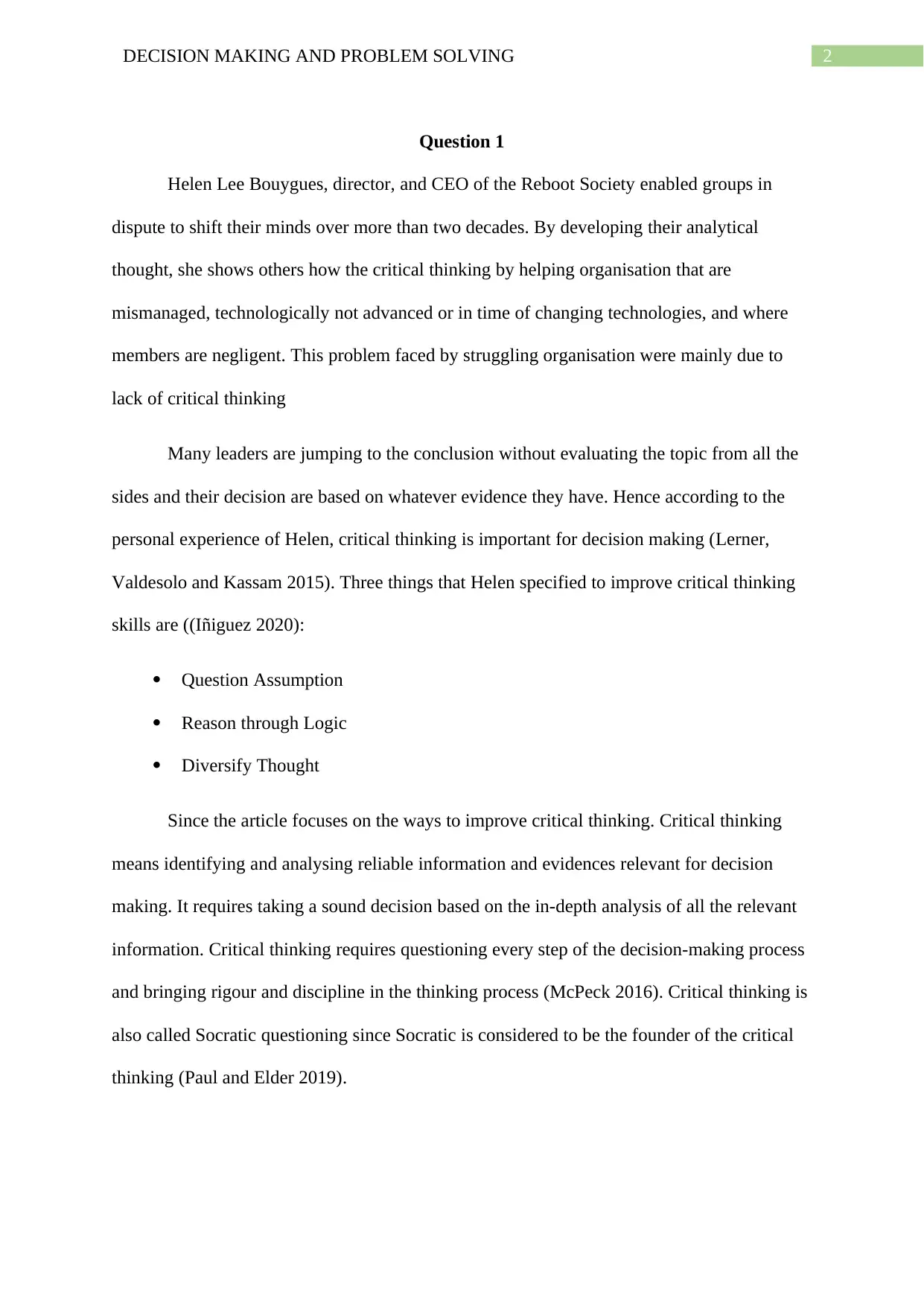
2DECISION MAKING AND PROBLEM SOLVING
Question 1
Helen Lee Bouygues, director, and CEO of the Reboot Society enabled groups in
dispute to shift their minds over more than two decades. By developing their analytical
thought, she shows others how the critical thinking by helping organisation that are
mismanaged, technologically not advanced or in time of changing technologies, and where
members are negligent. This problem faced by struggling organisation were mainly due to
lack of critical thinking
Many leaders are jumping to the conclusion without evaluating the topic from all the
sides and their decision are based on whatever evidence they have. Hence according to the
personal experience of Helen, critical thinking is important for decision making (Lerner,
Valdesolo and Kassam 2015). Three things that Helen specified to improve critical thinking
skills are ((Iñiguez 2020):
Question Assumption
Reason through Logic
Diversify Thought
Since the article focuses on the ways to improve critical thinking. Critical thinking
means identifying and analysing reliable information and evidences relevant for decision
making. It requires taking a sound decision based on the in-depth analysis of all the relevant
information. Critical thinking requires questioning every step of the decision-making process
and bringing rigour and discipline in the thinking process (McPeck 2016). Critical thinking is
also called Socratic questioning since Socratic is considered to be the founder of the critical
thinking (Paul and Elder 2019).
Question 1
Helen Lee Bouygues, director, and CEO of the Reboot Society enabled groups in
dispute to shift their minds over more than two decades. By developing their analytical
thought, she shows others how the critical thinking by helping organisation that are
mismanaged, technologically not advanced or in time of changing technologies, and where
members are negligent. This problem faced by struggling organisation were mainly due to
lack of critical thinking
Many leaders are jumping to the conclusion without evaluating the topic from all the
sides and their decision are based on whatever evidence they have. Hence according to the
personal experience of Helen, critical thinking is important for decision making (Lerner,
Valdesolo and Kassam 2015). Three things that Helen specified to improve critical thinking
skills are ((Iñiguez 2020):
Question Assumption
Reason through Logic
Diversify Thought
Since the article focuses on the ways to improve critical thinking. Critical thinking
means identifying and analysing reliable information and evidences relevant for decision
making. It requires taking a sound decision based on the in-depth analysis of all the relevant
information. Critical thinking requires questioning every step of the decision-making process
and bringing rigour and discipline in the thinking process (McPeck 2016). Critical thinking is
also called Socratic questioning since Socratic is considered to be the founder of the critical
thinking (Paul and Elder 2019).
⊘ This is a preview!⊘
Do you want full access?
Subscribe today to unlock all pages.

Trusted by 1+ million students worldwide
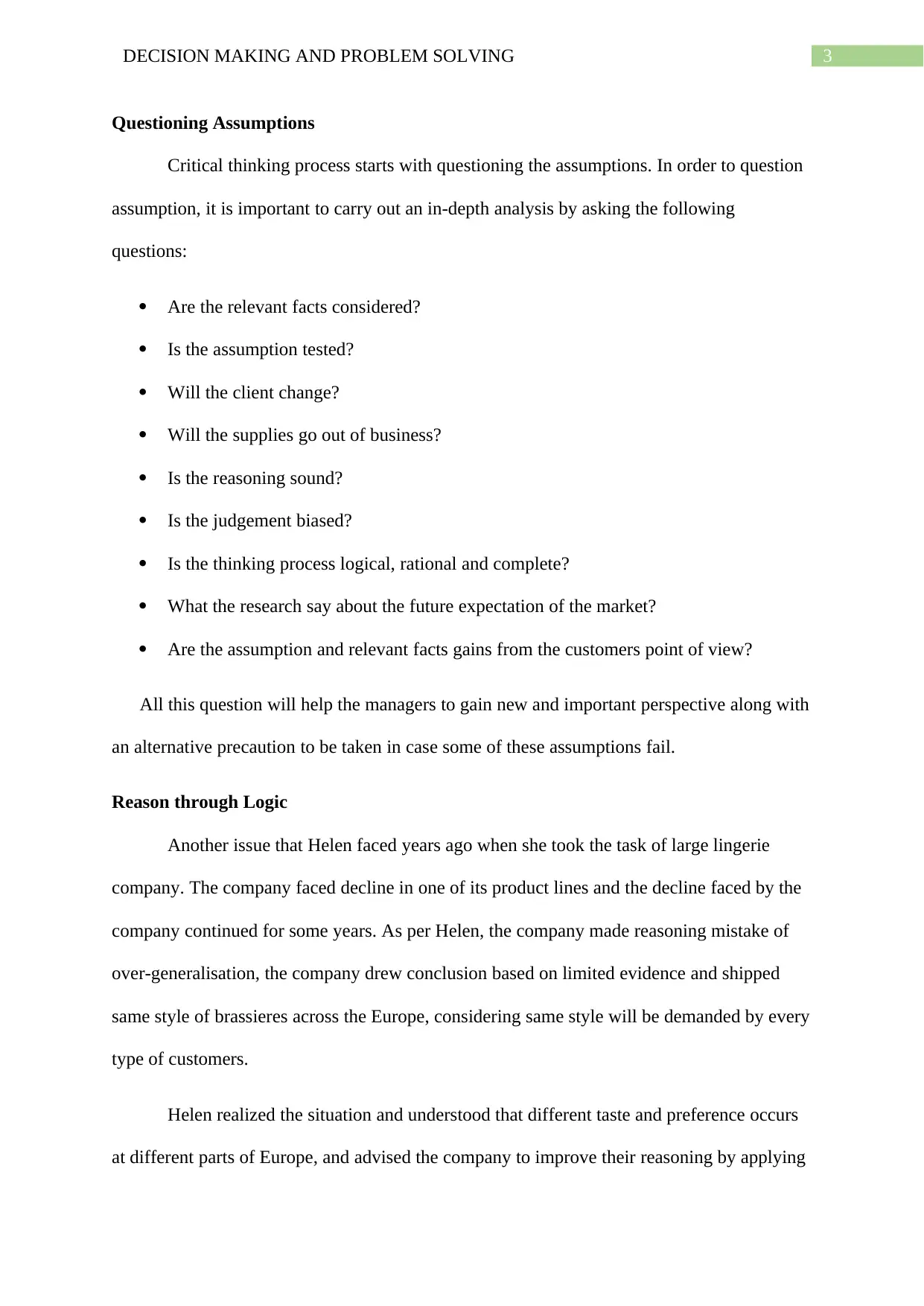
3DECISION MAKING AND PROBLEM SOLVING
Questioning Assumptions
Critical thinking process starts with questioning the assumptions. In order to question
assumption, it is important to carry out an in-depth analysis by asking the following
questions:
Are the relevant facts considered?
Is the assumption tested?
Will the client change?
Will the supplies go out of business?
Is the reasoning sound?
Is the judgement biased?
Is the thinking process logical, rational and complete?
What the research say about the future expectation of the market?
Are the assumption and relevant facts gains from the customers point of view?
All this question will help the managers to gain new and important perspective along with
an alternative precaution to be taken in case some of these assumptions fail.
Reason through Logic
Another issue that Helen faced years ago when she took the task of large lingerie
company. The company faced decline in one of its product lines and the decline faced by the
company continued for some years. As per Helen, the company made reasoning mistake of
over-generalisation, the company drew conclusion based on limited evidence and shipped
same style of brassieres across the Europe, considering same style will be demanded by every
type of customers.
Helen realized the situation and understood that different taste and preference occurs
at different parts of Europe, and advised the company to improve their reasoning by applying
Questioning Assumptions
Critical thinking process starts with questioning the assumptions. In order to question
assumption, it is important to carry out an in-depth analysis by asking the following
questions:
Are the relevant facts considered?
Is the assumption tested?
Will the client change?
Will the supplies go out of business?
Is the reasoning sound?
Is the judgement biased?
Is the thinking process logical, rational and complete?
What the research say about the future expectation of the market?
Are the assumption and relevant facts gains from the customers point of view?
All this question will help the managers to gain new and important perspective along with
an alternative precaution to be taken in case some of these assumptions fail.
Reason through Logic
Another issue that Helen faced years ago when she took the task of large lingerie
company. The company faced decline in one of its product lines and the decline faced by the
company continued for some years. As per Helen, the company made reasoning mistake of
over-generalisation, the company drew conclusion based on limited evidence and shipped
same style of brassieres across the Europe, considering same style will be demanded by every
type of customers.
Helen realized the situation and understood that different taste and preference occurs
at different parts of Europe, and advised the company to improve their reasoning by applying
Paraphrase This Document
Need a fresh take? Get an instant paraphrase of this document with our AI Paraphraser
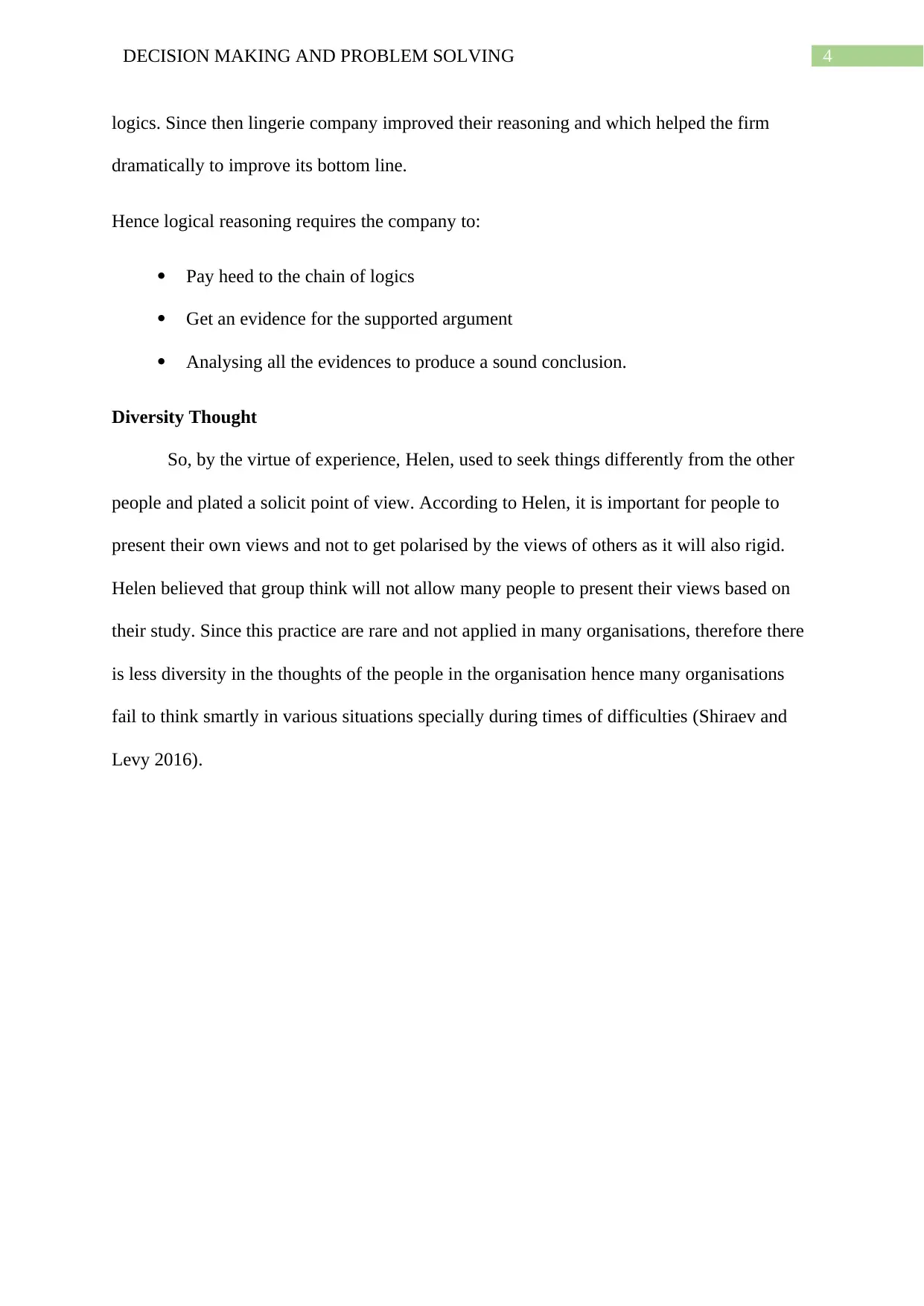
4DECISION MAKING AND PROBLEM SOLVING
logics. Since then lingerie company improved their reasoning and which helped the firm
dramatically to improve its bottom line.
Hence logical reasoning requires the company to:
Pay heed to the chain of logics
Get an evidence for the supported argument
Analysing all the evidences to produce a sound conclusion.
Diversity Thought
So, by the virtue of experience, Helen, used to seek things differently from the other
people and plated a solicit point of view. According to Helen, it is important for people to
present their own views and not to get polarised by the views of others as it will also rigid.
Helen believed that group think will not allow many people to present their views based on
their study. Since this practice are rare and not applied in many organisations, therefore there
is less diversity in the thoughts of the people in the organisation hence many organisations
fail to think smartly in various situations specially during times of difficulties (Shiraev and
Levy 2016).
logics. Since then lingerie company improved their reasoning and which helped the firm
dramatically to improve its bottom line.
Hence logical reasoning requires the company to:
Pay heed to the chain of logics
Get an evidence for the supported argument
Analysing all the evidences to produce a sound conclusion.
Diversity Thought
So, by the virtue of experience, Helen, used to seek things differently from the other
people and plated a solicit point of view. According to Helen, it is important for people to
present their own views and not to get polarised by the views of others as it will also rigid.
Helen believed that group think will not allow many people to present their views based on
their study. Since this practice are rare and not applied in many organisations, therefore there
is less diversity in the thoughts of the people in the organisation hence many organisations
fail to think smartly in various situations specially during times of difficulties (Shiraev and
Levy 2016).
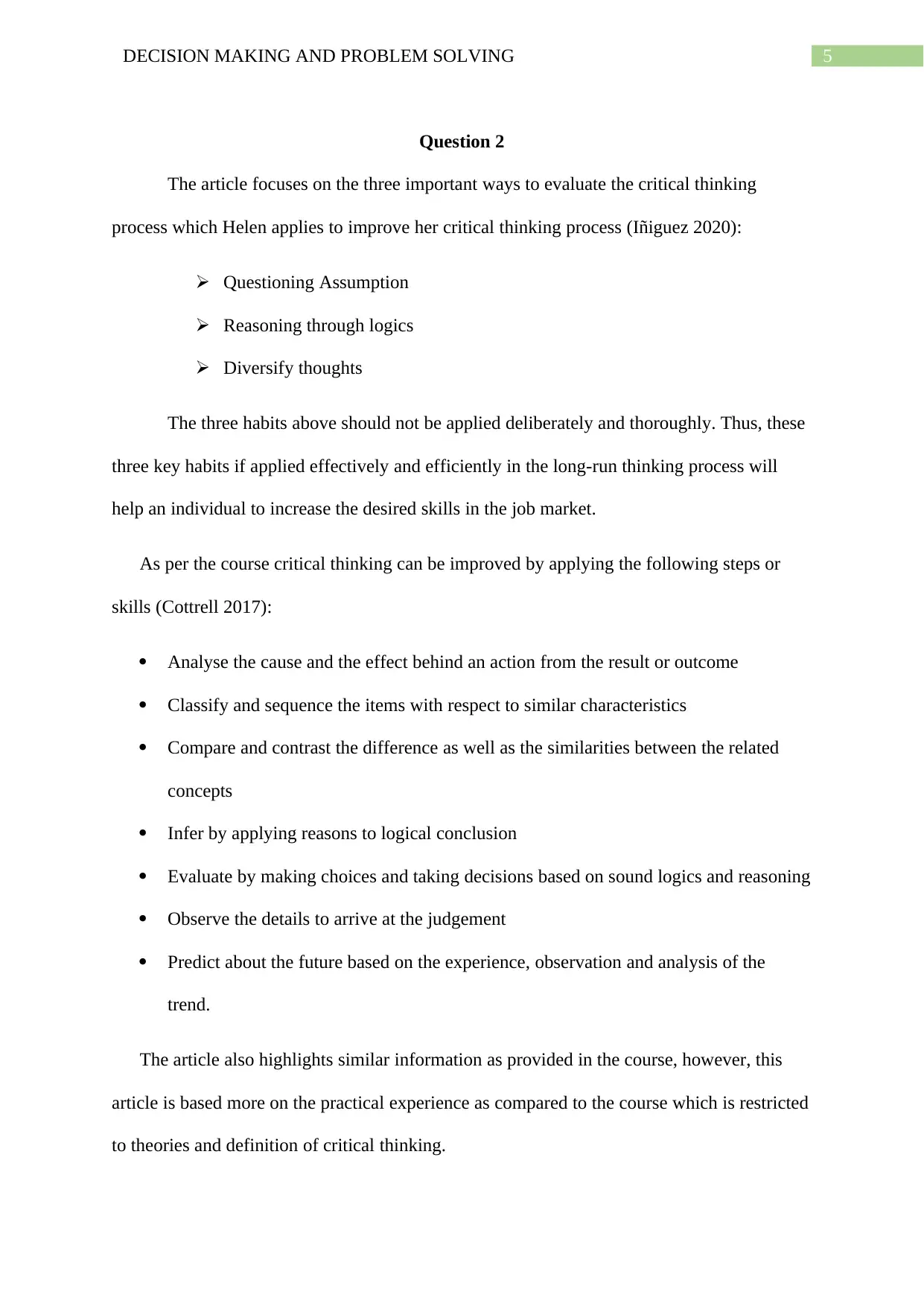
5DECISION MAKING AND PROBLEM SOLVING
Question 2
The article focuses on the three important ways to evaluate the critical thinking
process which Helen applies to improve her critical thinking process (Iñiguez 2020):
Questioning Assumption
Reasoning through logics
Diversify thoughts
The three habits above should not be applied deliberately and thoroughly. Thus, these
three key habits if applied effectively and efficiently in the long-run thinking process will
help an individual to increase the desired skills in the job market.
As per the course critical thinking can be improved by applying the following steps or
skills (Cottrell 2017):
Analyse the cause and the effect behind an action from the result or outcome
Classify and sequence the items with respect to similar characteristics
Compare and contrast the difference as well as the similarities between the related
concepts
Infer by applying reasons to logical conclusion
Evaluate by making choices and taking decisions based on sound logics and reasoning
Observe the details to arrive at the judgement
Predict about the future based on the experience, observation and analysis of the
trend.
The article also highlights similar information as provided in the course, however, this
article is based more on the practical experience as compared to the course which is restricted
to theories and definition of critical thinking.
Question 2
The article focuses on the three important ways to evaluate the critical thinking
process which Helen applies to improve her critical thinking process (Iñiguez 2020):
Questioning Assumption
Reasoning through logics
Diversify thoughts
The three habits above should not be applied deliberately and thoroughly. Thus, these
three key habits if applied effectively and efficiently in the long-run thinking process will
help an individual to increase the desired skills in the job market.
As per the course critical thinking can be improved by applying the following steps or
skills (Cottrell 2017):
Analyse the cause and the effect behind an action from the result or outcome
Classify and sequence the items with respect to similar characteristics
Compare and contrast the difference as well as the similarities between the related
concepts
Infer by applying reasons to logical conclusion
Evaluate by making choices and taking decisions based on sound logics and reasoning
Observe the details to arrive at the judgement
Predict about the future based on the experience, observation and analysis of the
trend.
The article also highlights similar information as provided in the course, however, this
article is based more on the practical experience as compared to the course which is restricted
to theories and definition of critical thinking.
⊘ This is a preview!⊘
Do you want full access?
Subscribe today to unlock all pages.

Trusted by 1+ million students worldwide
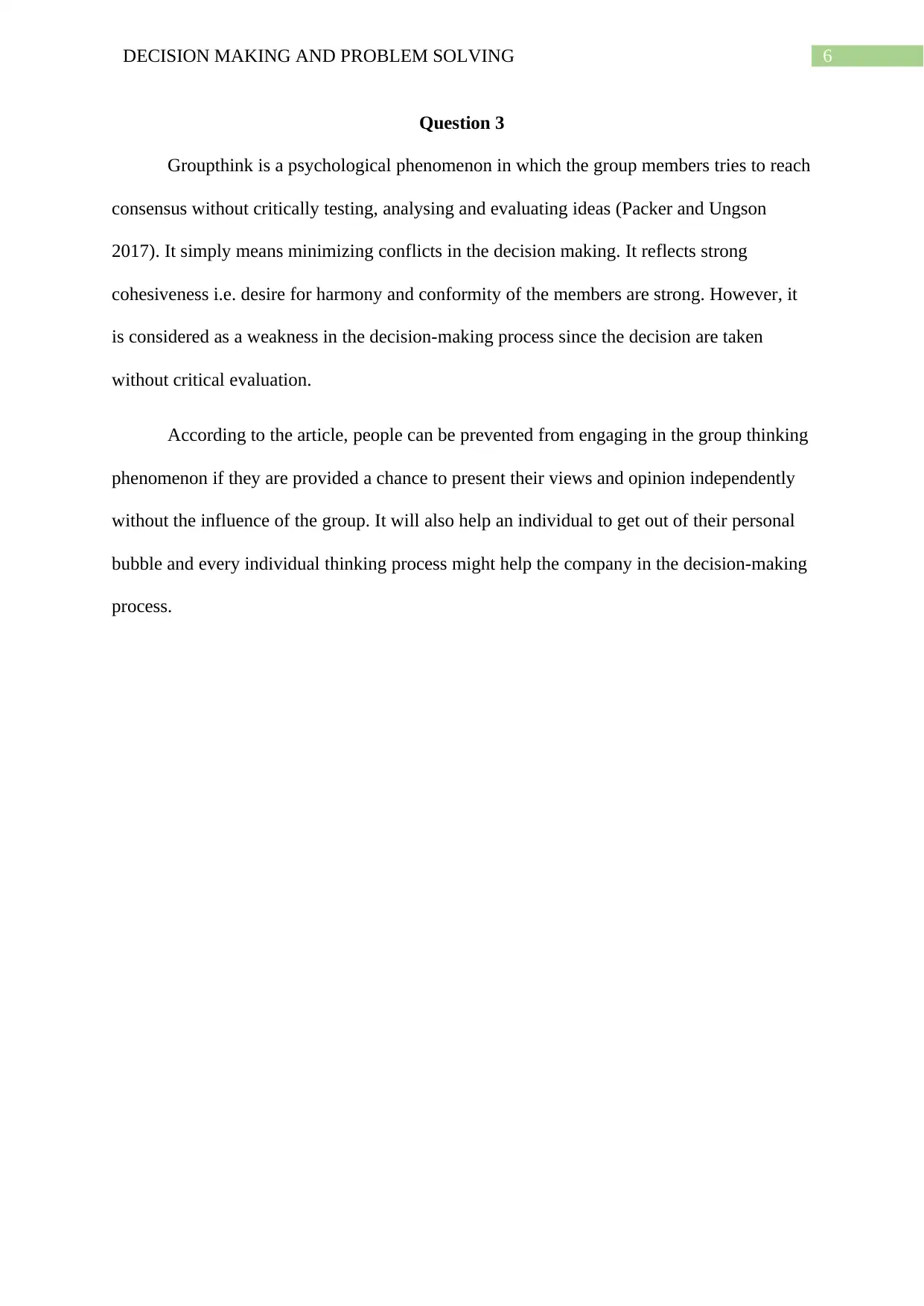
6DECISION MAKING AND PROBLEM SOLVING
Question 3
Groupthink is a psychological phenomenon in which the group members tries to reach
consensus without critically testing, analysing and evaluating ideas (Packer and Ungson
2017). It simply means minimizing conflicts in the decision making. It reflects strong
cohesiveness i.e. desire for harmony and conformity of the members are strong. However, it
is considered as a weakness in the decision-making process since the decision are taken
without critical evaluation.
According to the article, people can be prevented from engaging in the group thinking
phenomenon if they are provided a chance to present their views and opinion independently
without the influence of the group. It will also help an individual to get out of their personal
bubble and every individual thinking process might help the company in the decision-making
process.
Question 3
Groupthink is a psychological phenomenon in which the group members tries to reach
consensus without critically testing, analysing and evaluating ideas (Packer and Ungson
2017). It simply means minimizing conflicts in the decision making. It reflects strong
cohesiveness i.e. desire for harmony and conformity of the members are strong. However, it
is considered as a weakness in the decision-making process since the decision are taken
without critical evaluation.
According to the article, people can be prevented from engaging in the group thinking
phenomenon if they are provided a chance to present their views and opinion independently
without the influence of the group. It will also help an individual to get out of their personal
bubble and every individual thinking process might help the company in the decision-making
process.
Paraphrase This Document
Need a fresh take? Get an instant paraphrase of this document with our AI Paraphraser
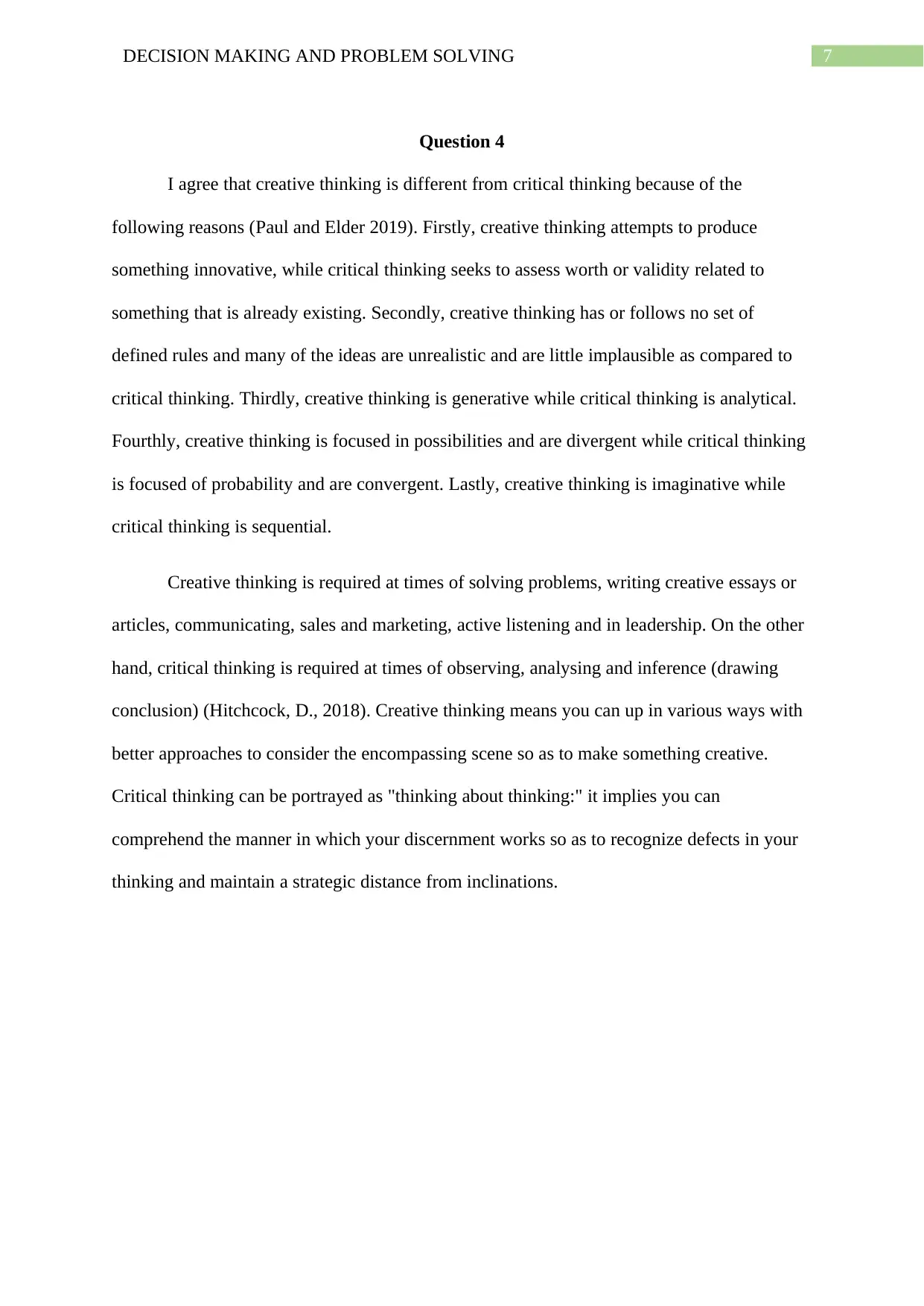
7DECISION MAKING AND PROBLEM SOLVING
Question 4
I agree that creative thinking is different from critical thinking because of the
following reasons (Paul and Elder 2019). Firstly, creative thinking attempts to produce
something innovative, while critical thinking seeks to assess worth or validity related to
something that is already existing. Secondly, creative thinking has or follows no set of
defined rules and many of the ideas are unrealistic and are little implausible as compared to
critical thinking. Thirdly, creative thinking is generative while critical thinking is analytical.
Fourthly, creative thinking is focused in possibilities and are divergent while critical thinking
is focused of probability and are convergent. Lastly, creative thinking is imaginative while
critical thinking is sequential.
Creative thinking is required at times of solving problems, writing creative essays or
articles, communicating, sales and marketing, active listening and in leadership. On the other
hand, critical thinking is required at times of observing, analysing and inference (drawing
conclusion) (Hitchcock, D., 2018). Creative thinking means you can up in various ways with
better approaches to consider the encompassing scene so as to make something creative.
Critical thinking can be portrayed as "thinking about thinking:" it implies you can
comprehend the manner in which your discernment works so as to recognize defects in your
thinking and maintain a strategic distance from inclinations.
Question 4
I agree that creative thinking is different from critical thinking because of the
following reasons (Paul and Elder 2019). Firstly, creative thinking attempts to produce
something innovative, while critical thinking seeks to assess worth or validity related to
something that is already existing. Secondly, creative thinking has or follows no set of
defined rules and many of the ideas are unrealistic and are little implausible as compared to
critical thinking. Thirdly, creative thinking is generative while critical thinking is analytical.
Fourthly, creative thinking is focused in possibilities and are divergent while critical thinking
is focused of probability and are convergent. Lastly, creative thinking is imaginative while
critical thinking is sequential.
Creative thinking is required at times of solving problems, writing creative essays or
articles, communicating, sales and marketing, active listening and in leadership. On the other
hand, critical thinking is required at times of observing, analysing and inference (drawing
conclusion) (Hitchcock, D., 2018). Creative thinking means you can up in various ways with
better approaches to consider the encompassing scene so as to make something creative.
Critical thinking can be portrayed as "thinking about thinking:" it implies you can
comprehend the manner in which your discernment works so as to recognize defects in your
thinking and maintain a strategic distance from inclinations.
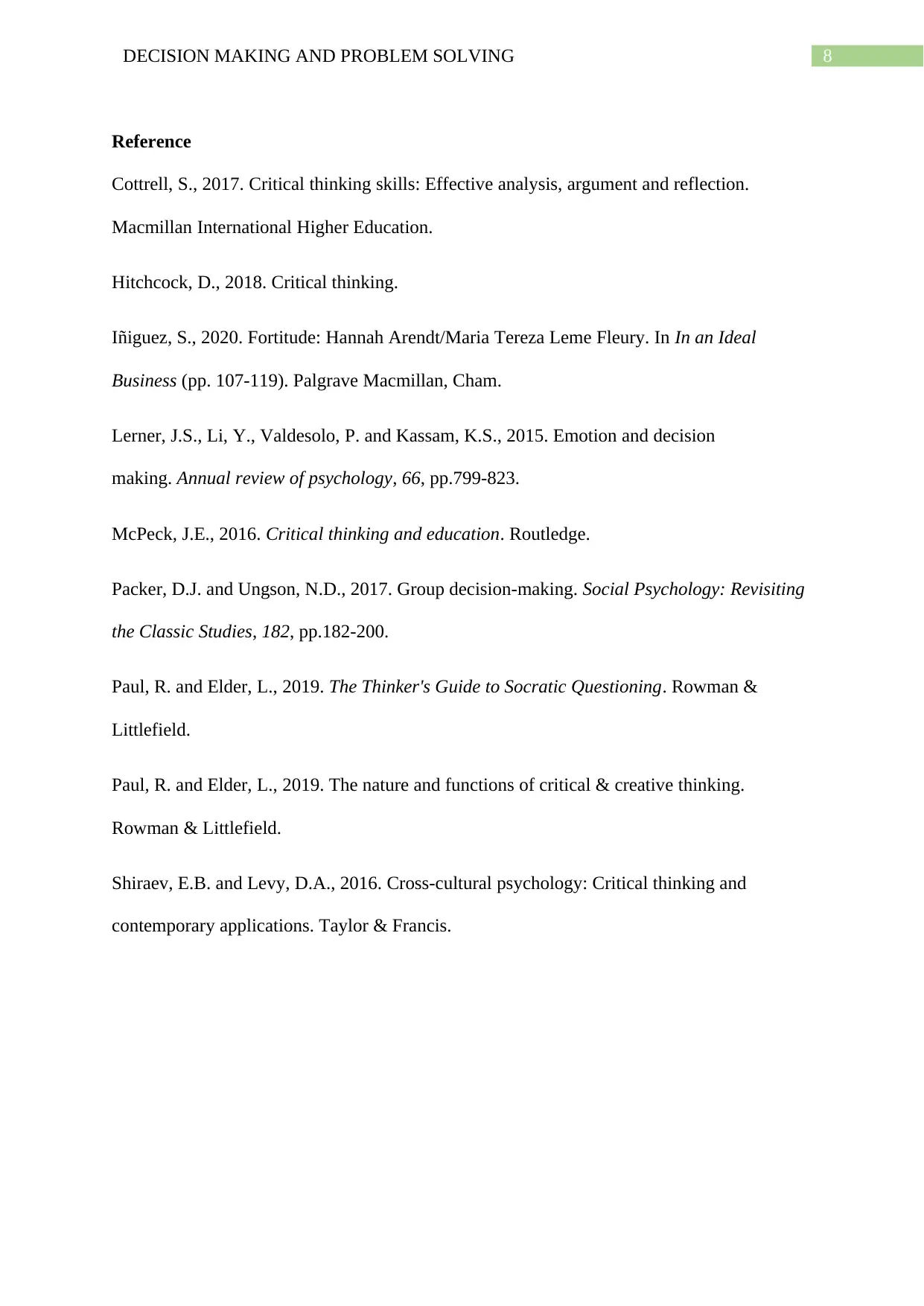
8DECISION MAKING AND PROBLEM SOLVING
Reference
Cottrell, S., 2017. Critical thinking skills: Effective analysis, argument and reflection.
Macmillan International Higher Education.
Hitchcock, D., 2018. Critical thinking.
Iñiguez, S., 2020. Fortitude: Hannah Arendt/Maria Tereza Leme Fleury. In In an Ideal
Business (pp. 107-119). Palgrave Macmillan, Cham.
Lerner, J.S., Li, Y., Valdesolo, P. and Kassam, K.S., 2015. Emotion and decision
making. Annual review of psychology, 66, pp.799-823.
McPeck, J.E., 2016. Critical thinking and education. Routledge.
Packer, D.J. and Ungson, N.D., 2017. Group decision-making. Social Psychology: Revisiting
the Classic Studies, 182, pp.182-200.
Paul, R. and Elder, L., 2019. The Thinker's Guide to Socratic Questioning. Rowman &
Littlefield.
Paul, R. and Elder, L., 2019. The nature and functions of critical & creative thinking.
Rowman & Littlefield.
Shiraev, E.B. and Levy, D.A., 2016. Cross-cultural psychology: Critical thinking and
contemporary applications. Taylor & Francis.
Reference
Cottrell, S., 2017. Critical thinking skills: Effective analysis, argument and reflection.
Macmillan International Higher Education.
Hitchcock, D., 2018. Critical thinking.
Iñiguez, S., 2020. Fortitude: Hannah Arendt/Maria Tereza Leme Fleury. In In an Ideal
Business (pp. 107-119). Palgrave Macmillan, Cham.
Lerner, J.S., Li, Y., Valdesolo, P. and Kassam, K.S., 2015. Emotion and decision
making. Annual review of psychology, 66, pp.799-823.
McPeck, J.E., 2016. Critical thinking and education. Routledge.
Packer, D.J. and Ungson, N.D., 2017. Group decision-making. Social Psychology: Revisiting
the Classic Studies, 182, pp.182-200.
Paul, R. and Elder, L., 2019. The Thinker's Guide to Socratic Questioning. Rowman &
Littlefield.
Paul, R. and Elder, L., 2019. The nature and functions of critical & creative thinking.
Rowman & Littlefield.
Shiraev, E.B. and Levy, D.A., 2016. Cross-cultural psychology: Critical thinking and
contemporary applications. Taylor & Francis.
⊘ This is a preview!⊘
Do you want full access?
Subscribe today to unlock all pages.

Trusted by 1+ million students worldwide
1 out of 9
Related Documents
Your All-in-One AI-Powered Toolkit for Academic Success.
+13062052269
info@desklib.com
Available 24*7 on WhatsApp / Email
![[object Object]](/_next/static/media/star-bottom.7253800d.svg)
Unlock your academic potential
Copyright © 2020–2025 A2Z Services. All Rights Reserved. Developed and managed by ZUCOL.





